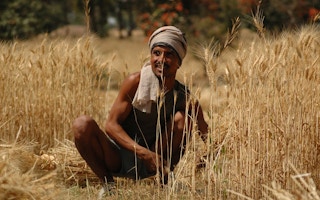Seeking to boost interest in agriculture in his part of southern India, K. Rajendra quit his job running a computer training institute five years ago and now uses YouTube videos and WhatsApp messages to promote “natural farming” to young people.
“Most farmers in this region are aged between 60 and 80. Parents don’t want their children to do farming, and ask them to migrate to cities,” he said.
“Who will take farming forward?” asked Rajendra, 42, as his staff stacked organically grown lentils, rice and spices on shelves at his store in N.T.R District in Andhra Pradesh.
His work is part of a wider project in the state where about 800,000 farmers, most of them smallholders, have embraced natural farming - up from 40,000 when the state government launched a “community-managed natural farming” scheme in 2015.
Natural farming shuns synthetic fertilisers and pesticides, and involves the use of handmade or organic manure, growing multiple crops instead of one, and no tilling of the land.
In the past, ‘Rhythu Rajendra’, or ‘Farmer Rajendra’ as he likes to be known, helped students chase their dreams of finding jobs as software engineers, especially in the United States.
Nowadays, he uploads videos of his natural farm on YouTube, runs more than a dozen groups on WhatsApp with over 100 farmers each to showcase techniques, and encourages young people to try their hand.
Among the recruits, his 17-year-old son has started helping him on the farm.
The Andhra Pradesh project aims to protect agricultural livelihoods by improving crop yields and farmers’ health, while cutting spending on chemical fertilisers and pesticides and reducing greenhouse gas emissions.
Globally, agriculture accounts for about 17 per cent of humanity’s planet-heating emissions, according to UN data for 2018.
The Asia-Pacific region is responsible for the highest emissions because of synthetic fertiliser use in rice cultivation, according to the Asian Development Bank.
Farmer numbers drop as climate heats up
Across India, farmer numbers overall have dropped in recent decades as the business has become cost-intensive and riskier. Many doubt that natural farming will work on a large scale, fearing lower production and earnings.
Agriculture is still the biggest employer in the world’s most populous nation, engaging 250 million people. But it accounted for 44 per cent of total employment in 2021, down from 64 per cent in 1991, World Bank data shows.
Climate change is making living off farming tough as it hits harvests, fuelling debt, migration and farmer suicides.
Nearly 11,000 farmers and agricultural labourers took their own lives in India in 2021, government data shows.
Some farmers are trying to cope with losses to droughts and floods by using more chemical fertilisers to increase yields.
Others are joining green farming projects, which have taken root in India. But experts say their scale and success hinges on how well they can protect incomes for poor farmers.
Among the converts is Jalagam Syam, 34, who quit his pharmaceuticals job and returned to his parents’ farm. He believes common stomach, skin and lung ailments in the region are linked to agricultural chemicals.
“The soil and air we breathe is already damaged. At this rate there won’t be any food to eat in the future,” he said.
But transitioning to natural farming brings challenges in one of India’s top rice-producing regions, which is also among the most vulnerable to climate change and where farmers’ incomes are wedded to the staple crop.
Sadhupati Srinivas Rao, 42, who grows cotton and paddy on an 80-acre farm in Chevaturu village, has spent 1.6 million rupees (US$19,220) annually on fertilisers in the last two years.
“I farm on leased land and the landowner seeks profit,” he said, explaining why he had not switched to natural farming.
The ecological push seeks to “find a long-term solution to the crisis in farmers’ livelihoods”, said T. Vijay Kumar, who leads the state’s natural farming project.
Eight years on, the Andhra Pradesh project is aiming to insulate farm yields from erratic rains and extreme heat.
“I can’t think of any farming method that is more relevant now, or in the context of what is going to come in terms of climate uncertainties,” said Vijay Kumar, who is also executive vice-chairman of a state corporation for empowering farmers.
“We have made a beginning,” he said.
Harvests fall then rebound
Officials say natural farming, if done right, can yield the same or better harvests than farming using chemicals.
Those who have made the switch said their per-acre yield of rice dropped in the initial years to 18 bags of 75 kg from more than 45 bags with chemical farming - but harvests then picked up gradually as the soil health recovered.
The fall in yields was offset by up to 25 per cent higher prices for natural produce and by big savings from ditching chemical fertilisers and pesticides, they added.
Nonetheless, many larger farmers find the natural farming processes of weeding and mixing manure labour-intensive. Nearly 80 per cent of farmers who have signed up for the green approach own less than five acres of land.
And fertiliser use has continued to rise across India, jumping about ten-fold from 1970 to 54 kg per acre in 2016. In Andhra Pradesh, it is now 100 kg per acre, officials said.










